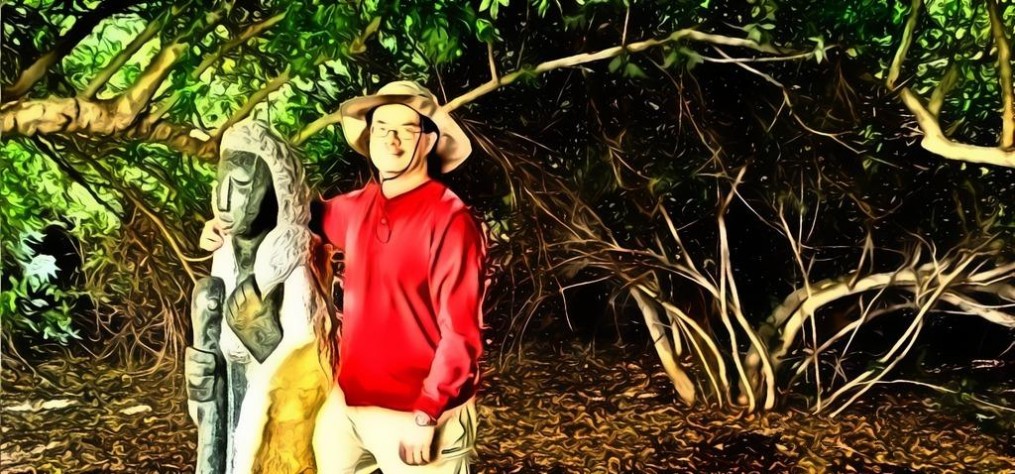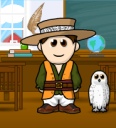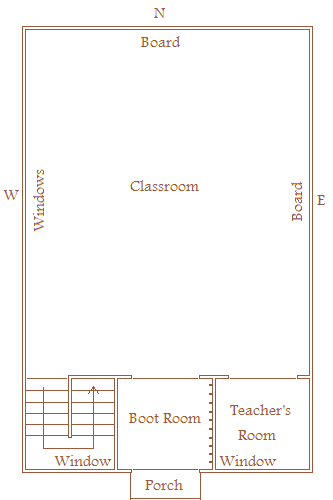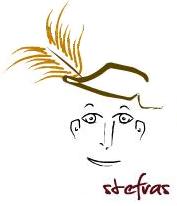In a previous post I described the significance of my blogging avatar. It essentially represents the teaching and naturalist/ecologist sides of me.
Some of you have noticed that my blogging avatar and tweeting avatar are not the same.
You are right.
A month ago, on the Ides of May, @royanlee inquired about my Twitter avatar. His exact query was:
@stefras your profile pic is intriguing.
@Mstew15 noted (just recently as part of a conversation):
DM stefras A ton of history, it looks like! Where was it taken? This can’t be a current-day classroom…can it?
My response is this post.
In the days of settlers and homesteaders
My Twitter avatar is a cropped view of the inside of an early 20th Century, one-room Canadian Prairie school. Actually, this one:
This school is special because it represents the history of:
- my family, and
- the Canadian and Saskatchewan school systems.
Connections: My family and Jedburgh School
One of my paternal great uncles and one of my paternal great aunts were two of the first students to attend this school in the 1920s. Also, for the wage of 75¢ to $4.50 (1934 CAN) a day, their father, my great grandfather, was the caretaker of the school from 1933 to 1935.
Preservation: The state of Jedburgh School
Jedburgh School actually contains three rooms — the coat or boot room, the teacher’s office (of the same size) and the classroom — plus a basement, where likely the teacher lived (the basement is flooded with water and diesel, so I never saw it).
My Twitter avatar comes from the classroom.
The school operated for over 60 years until the mid-1980s. When it was closed, it was converted into a library which lasted until 1991. After that, as the village waned (it is now a hamlet), the school was abandoned and left to its fate. In it were left desks, school books, school ledgers and other material. Even the chalkboards were left unerased.
Mice now occupy the desks students once learned in and scuttle across the floor they once walked across, somewhat an ironic fate for the school, Jedburgh and their history, which once were the proud center of Garry County 245. Today the Seat of Garry County, the post office, a quarter dozen occupied homes, the same number of abandoned buildings, the Church and the abandoned school are all that remain of the once bustling village.
The school is poised to soon collapse or be rescued. The Theodore Historical Society and the Saskatchewan Archives Board are in the process of salvaging as much of the contents of the school as they can.
Like the grain elevators that once dotted the Canadian Prairies, the one-room school houses are abandoned and disappearing.
Part of the reason I chose the inside of Jedburgh School for my avatar, after symbolizing my family’s history and that of pioneer Canadian education, was to record the existence of this school and its contents as a way of saving or preserving these.
For more photos of the school and detailed captions for all the photos, refer to my Jedburgh School, Saskatchewan, photo set. In addition, take a look around Jedburgh (also), read stories about it and view it on a Google Earth map.
On the map, zoom in to the fifth rung from the top. The white smudge East of 1stE between the stamped 0 and 2 is the school. The dark box South of Jedburgh across Highway 651 is the windrow around the yard of the Sts. Peter and Paul Ukrainian Catholic Church, which is still occasionally active. And the dark (treed) trail continuing South West of the Church was the driveway into my great uncle’s farm where I used to explore. Some German man currently uses this driveway as a private shooting range.
 Jedburgh Sts. Peter and Paul Ukrainian Catholic Church © 2010 Shawn Urban | more info (via: stefras)
Jedburgh Sts. Peter and Paul Ukrainian Catholic Church © 2010 Shawn Urban | more info (via: stefras)
Avatar’s meaning: Into the school
Progress: Keep asking questions
George Couros in his post, Keep Asking Questions, lists “Would we be doing this if we started schools from scratch?” as a key question to ask when considering a tool for or method of teaching.
To answer this question, we need to define what we mean by schools and scratch. And we need to agree upon a definition of success, because, with no idea of what success looks like, we can never answer the question. In fact, we could not even ask it.
What Kind of World Do You Want?
by NASA 2011
Defining schools: Is a school where we learn? Or is a more formal definition needed? Is a schoolhouse necessary? Or are alternatives better?
Defining scratch: If we were to start from scratch by completely abandoning the education systems we have now, including the infrastructure:
- What kind of schools would we build in place of today’s schools?
- What kind of teaching would we devise?
- What tools — resources both natural and man-made — would we use?
- What role, purpose or function would our schools serve? (In this stomps the elephant of hidden curriculum.)
- Who would we teach?
- And would we use lessons from our past and present to optimize future and present school effectiveness? (Would we plan with past and present triumphs and mistakes in mind?)
At this moment, completely abandoning the education systems we have now is impractical and idealistic. Teachers are left to modify the above questions or create new ones on their own. New questions arise, such as:
- Why am I teaching this given topic or concept?
- Why am I teaching it the way I do?
- What do I want my students to walk with for the rest of their lives?
- How do I most effectively help them do so?
- What exactly is the meaning of this piece of education?
I always consider these questions as I teach. I am a big fan of why? both on my students and on me. It seems we are so stuck on how? and the shortcut mnemonics (formulaic teaching) that how? develops, that we forget to explore why?. I believe many students struggle because of this very bias and deficiency. I know, when I was as kid, I did.
Defining success: One final set of questions can also be explored. What are the educational needs and wants (priorities) of our:
- community and culture (local, regional, national, global, present and future)?
- students (in light of their potential futures or adulthoods)?
- students (in light of their dynamic presents or childhoods/adolescences)?
- students’ parents (in light of their dreams for their kids’ successes)?
- selves (in light of our desire to be successful caring professionals who seek to aid our students toward their successes)?
Success is a measure of the degree to which priorities are met. It is optimally met at best, due to the conflict of the priorities of interested parties. It also dynamic, for as a person lives, what he or she requires and uses changes. Community, culture and parents change their priorities as well.
Reflection: What is success?
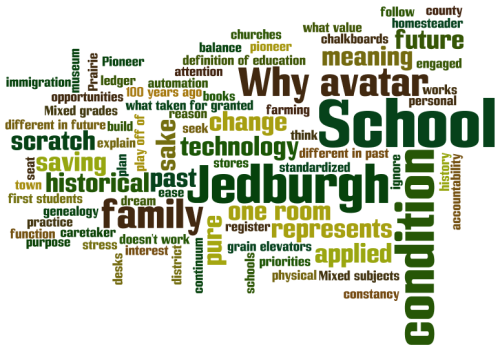 Jedburgh Wordle Shawn Urban(via: Wordle)
Jedburgh Wordle Shawn Urban(via: Wordle)
Our past informs our future. Without it we can not measure how we are doing today nor plan how we can change tomorrow. It also informs the struggle of our ancestors, the ones who cut the trail we now follow, and it informs the trail our descendents will follow that we cut in our turn.
It is interesting to contrast and compare the schools of yesterday with those of today, like Tom Grant did; to imagine how schools in the days of the Prairie pioneers and homesteaders would be different if they had today’s technology (in the preferable sociological and anthropological senses) at their disposal; and to imagine how today’s schools would be different if we truly wiped the slates clean and designed them again from scratch.
In the days of settlers and homesteaders, the Canadian Ukrainian country pioneer occupied himself with clearing and farming her land or with supporting the farmer in this endeavor. Farming therefore was the homesteader’s priority.
The meaning of education and school was coloured by this pioneer agrarian culture. Priorities, things valued, things stressed, things ignored and things taken for granted were different from today. The population was less established and much more sparse. So, it is not surprising that education reflected these opportunities, challenges and circumstances. It was important but only so long as it did not interfere with farming. (For many Prairie farmers this still holds true.)
The pioneer school of the Prairies was a one-room building, often with a live-in teacher. In it several grades, age-levels and subjects were taught at once. And often these levels of interaction played off of each other in a holistic, sometimes even interdisciplinary, manner. Students often had the same teacher their whole school careers (which ended for most around Grade Eight) and the teacher had the same students throughout these careers. Interaction and relationships often ran deeper. Over time, more personal attention and engagement was afforded each student. The questions of accountability — who was accountable and why — rested more on the community and teacher. Standardization was less stringent than today and often came after the teaching.
Today, Canadians live in a settled if not established society. Education holds deeper significance and opportunity, and curriculum is standardized.
If we did truly wipe the educational slates clean and designed them again from scratch, in the context of today’s exploding technology, modern culture and yesterday’s pioneer past, how would these schools look? I think George Couros’s question is rather deep. Further, do we start to make these changes from the grass roots or from the top? Perhaps a collaboration would work? Who decides which reform is best? And in all of this what do the students think? And when do we ask them, for when are they informed enough to inform us about their priorities, both present and future?
Back to my avatar
Even though I am a substitute teacher, I try my best to encourage my students to ask why? alongside how?. I try to engage their curiosities and fascinate them with twists and disruptions of their universes. I see my role as the complement of their regular teachers that challenges them to imagine rather than accept.
My Twitter avatar calls me to action and reminds me to serve the children and future under my care for their betterment. When I look at my avatar, the principles, purposes and bases of modern education and how I teach reflect on me in the lights of past, present and future pedagogy.
Hopefully I also reflect on them. For just teaching is not enough. Making a lasting beneficial difference is.
Follow @stefras
